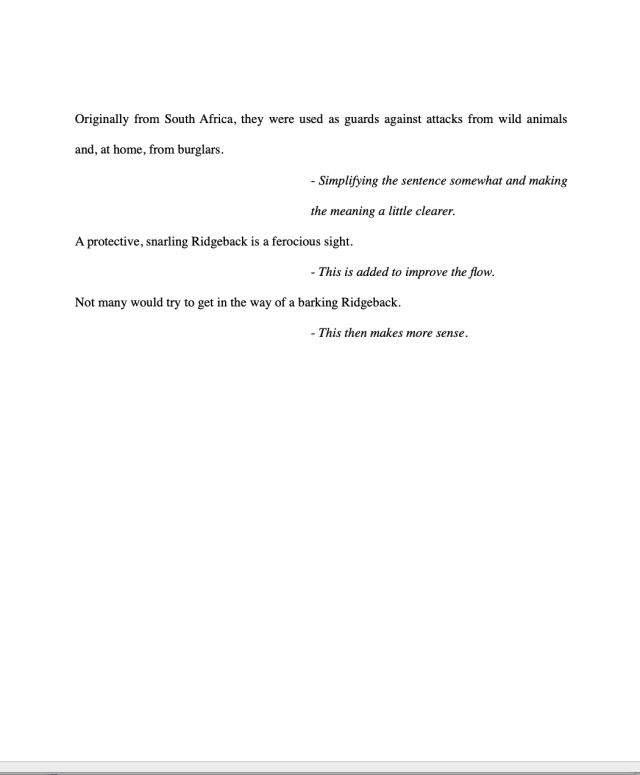Breaking Paragraphs – Student Help 3

This is the transcript of my latest video. In this I am talking about splitting paragraphs into their constituent sentences. By doing this, you can see where a paragraph is going wrong, where sentence structure is poor, and more easily see how to fix things! When sentences are embedded in their paragraph, it’s difficult, often, to read what is actually there. For the full video, go and watch it here.
Best of luck and I hope you find this useful.
Hello, and welcome to another writerly witterings. I am Michael Jecks. I have been a professional author for some 24 years, and I used to teach students at Exeter University on write and edit their essays.
However, this video is not only for students. It is for anyone who wants to communicate: for businesspeople, for those trying to write a letter of complaint, for those who want to apply for a job. Communication is vital. It’s a skill we all need in our daily lives. But sometimes things go wrong!
At Exeter, many problems developed because the students wanted to sound “academic”. To do that, they often tried to write enormously long sentences with as many polysyllabic words as possible. Once I was talking to a female student about an essay of hers, and pointed to a word in the middle of a paragraph. I asked her what it meant. She did not know. Sadly, it meant the opposite of what she wanted it to mean, and it made the paragraph literally incomprehensible.
Your tutors want to understand what you are thinking. They need to know you can form a logical argument. To do that, you have only to express your thoughts.
But don’t try to be too clever. Einstein once said that “if you can’t explain it to a six year old, you don’t understand it yourself”. An essay ideally should be explaining your thoughts to a youngster. Imagine you are explaining to a younger sibling. Write in that manner. Use short words and short sentences, because that way readers can follow you more easily.
But sometimes you get tangled up in words. You have a short draft, but over time you try to improve it. You add an extra long word to make the essay look and sound more academic. You extend sentences way beyond their reasonable extent, and try desperately to bind some form of meaning to them, but it’s like pinning the tail on the donkey. You cannot fix them in place.
Don’t panic, that is what this video is all about.
Incidentally, all the pages for this video as well as the transcript are available on my blog at WriterlyWitterings.com under the heading Student Help 3 – Paragraphs.
#1 This is a short paragraph I made up today. As you can see, it’s a very rough draft indeed. It doesn’t read well at all. There are a lot of problems with it.
#2 Here I have highlighted some of the problems with the text. There are lots of problems. Repetitions, changing from singular to plural, and misuse of apostrophes, among others. I have listed the issues on a page here available on WriterlyWitterings.com. The link is underneath this video. 
#3 First, when you have a paragraph that just doesn’t work for you, break it into sentences. That just means go to every full stop in the paragraph and put two carriage returns after it. If you do that, your paragraph will look like this:
#4 Now you can analyse each sentence in sequence. Let’s take the longest sentence here, which drags on for four lines.
#5 Break this sentence down into logical sections. You’ll need to add a few words or take some out, but all you are doing is splitting the sentence into several shorter ones. 
#6 Now you can put the shorter sentences back into the flow of the paragraph, replacing the long, horrible sentence with your shorter ones.
#7 Once you have put them all back in, it is time to read the sentences again and make sure about the grammar and structure.

#8 When you are happy with it, all you have to do is remove the carriage returns and you have a functioning paragraph once more. But now it is immediately readable and makes sense!
And that is pretty much it.
Remember, break the paragraph into manageable chunks, splitting it into sentences.
Assess whether the sentences are too long. Break up the ones that are just too long.
Break the bigger ones into smaller units; make them more manageable to a reader.
Make sure that you have a logical flow from one sentence to the next.
Remove the carriage returns to make one paragraph again.
Don’t forget to check all your paragraphs and analysing them as I showed in the last video. Breaking your essay down paragraph by paragraph is a very powerful tool to help make your writing easily comprehensible.
And that is that for now. I hope this has been useful. Please don’t forget to like the video, share it with your friends and subscribe if you want more hints and tricks to make your writing really effective. And apart from that, many thanks for watching, and if you want to see the examples of the text, follow the link in the section below, which will take you to my blog.
Thanks for watching, and see you soon!


